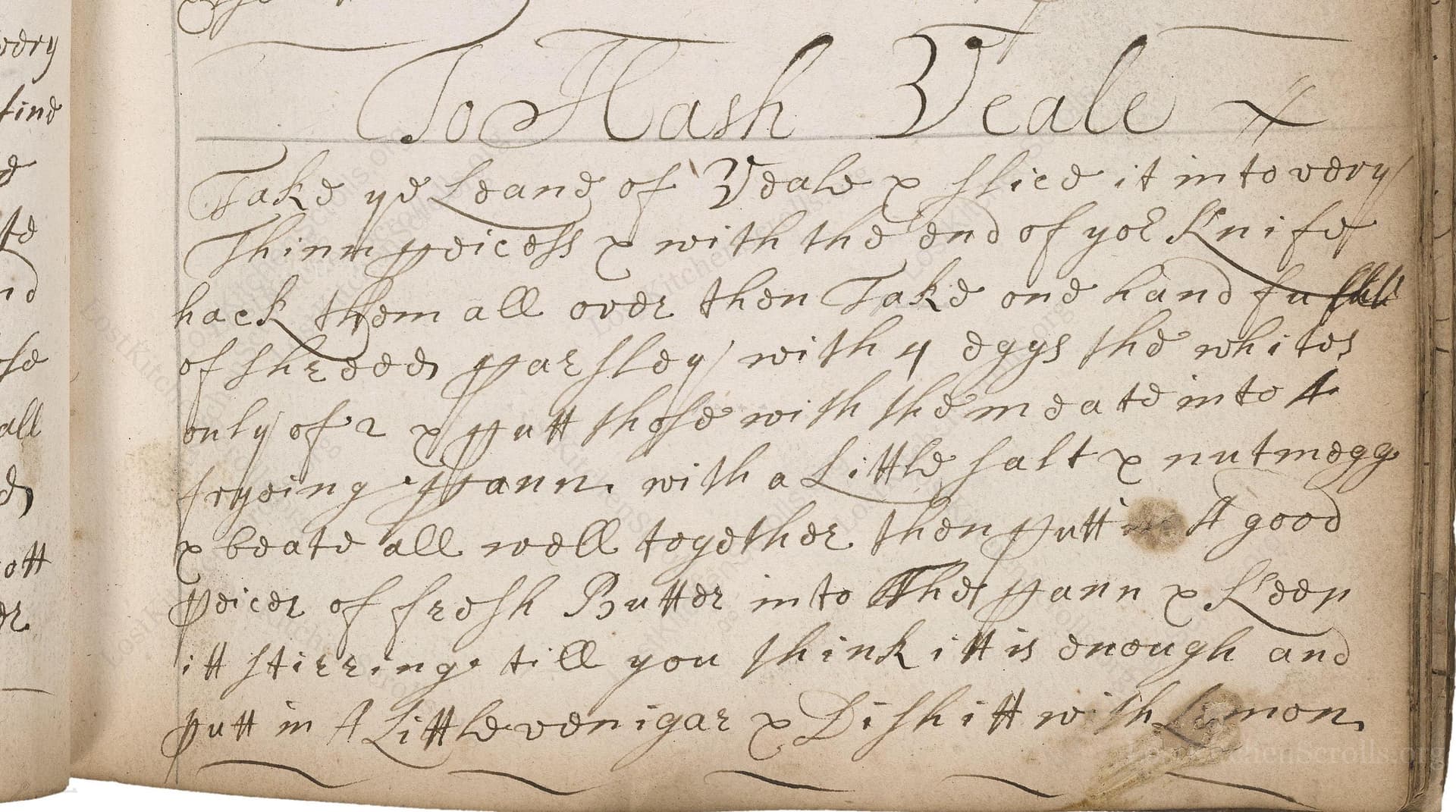To Hash Veale
From the treasured pages of Cookbook of Ann Smith, Reading
Written by Ann Smith

To Hash Veale
"Take your Loane of Veale & slied it into very thinne prices & with the back of your Knif hack them all over; then take ond hand full of shred parfly only of a hand full of a & putt those into frying pann, with a Little salt & nutmegg & toats all well togather; then putt a good Joice of fresh Butter into that pann & Loosen it stirring; till you think it is enough and putt in a little vinigar & Dish it with Lemon."
Note on the Original Text
The recipe's original form is concise and assumes prior kitchen knowledge. Spellings like 'Loane' (loin), 'slied' (sliced), 'parfly' (parsley), and 'toats' (toast or sauté) reflect 17th-century English, lacking standardized spelling or punctuation. Quantities are given more by intuition than precision ('hand full', 'Joice'), typical for the era, leaving much to the cook's judgment—hence modern clarifications above.

Title
Cookbook of Ann Smith, Reading (1698)
You can also click the book image above to peruse the original tome
Writer
Ann Smith
Era
1698
Publisher
Unknown
Background
Step into the sumptuous kitchens of 17th-century England with Ann Smith’s culinary treasury, where traditional recipes and time-honored techniques invite you to savor the flavors of history. Each page promises a feast of inspiration and a glimpse into the artful dining of a bygone era.
Kindly made available by
Folger Shakespeare Library
This recipe comes from the late 17th century, penned by Ann Smith in 1698. Veal was a favored ingredient at the English table, prized for its tenderness. The use of simple flavorings—parsley, nutmeg, salt, butter, vinegar, and lemon—reflects the early modern British fondness for balancing richness with a hint of sharpness or freshness. Recipes like this were often handwritten in household manuscript books passed down through generations, capturing the culinary habits and tastes of the period.

At the turn of the 18th century, the cook would have used a sharp kitchen knife, likely with a heavy bolster to hack the veal slices. A sturdy frying pan—possibly made from wrought iron or copper—would be set over an open hearth or on a trivet above hot coals. Wooden spoons or spatulas were used for stirring, and a mortar and pestle for grinding nutmeg. Lemons would be sliced with a small paring knife.
Prep Time
15 mins
Cook Time
10 mins
Servings
4
We've done our best to adapt this historical recipe for modern kitchens, but some details may still need refinement. We warmly welcome feedback from fellow cooks and culinary historians — your insights support the entire community!
Ingredients
- 1½ lbs veal loin, thinly sliced
- ½ oz fresh parsley, finely chopped
- ¼–½ tsp salt
- ¼ tsp ground nutmeg
- 3½ tbsp unsalted butter
- 2 tsp vinegar (white wine or cider vinegar recommended)
- Fresh lemon slices, to garnish
Instructions
- Begin by selecting a veal loin, preferably about 1½ lbs.
- Slice it as thinly as you can—think less than ¼ inch per piece.
- Use the back of your knive to gently tenderize (or 'hack') the slices.
- Take a large handful (about ½ oz) of fresh parsley, finely chopped.
- Heat a large frying pan over medium heat, and add the veal slices, chopped parsley, a generous pinch of salt (about ¼ to ½ tsp), and a pinch of nutmeg (about ¼ tsp).
- Toast these together in the pan for a couple of minutes, stirring to avoid burning.
- Then, add a good knob of unsalted butter (about 3½ tbsp) and stir well, letting everything sauté until the veal is just cooked—this may take 5-8 minutes, depending on thickness.
- Finish with a splash (2 tsp) of vinegar, and serve garnnished with thin slices of fresh lemon.
Estimated Calories
320 per serving
Cooking Estimates
It usually takes about 15 minutes to prepare the veal and ingredients. Cooking in the pan takes another 10 minutes. Each serving is about 320 calories if you divide the dish into 4 portions.
As noted above, we have made our best effort to translate and adapt this historical recipe for modern kitchens, taking into account ingredients nowadays, cooking techniques, measurements, and so on. However, historical recipes often contain assumptions that require interpretation.
We'd love for anyone to help improve these adaptations. Community contributions are highly welcome. If you have suggestions, corrections, or cooking tips based on your experience with this recipe, please share them below.
Join the Discussion
Rate This Recipe
Dietary Preference
Culinary Technique
Occasions

Den Bockfisch In Einer Fleisch Suppen Zu Kochen
This recipe hails from a German manuscript cookbook compiled in 1696, a time whe...

Die Grieß Nudlen Zumachen
This recipe comes from a rather mysterious manuscript cookbook, penned anonymous...

Ein Boudain
This recipe comes from an anonymous German-language manuscript cookbook from 169...

Ein Gesaltzen Citroni
This recipe, dating from 1696, comes from an extensive anonymous German cookbook...
Browse our complete collection of time-honored recipes



